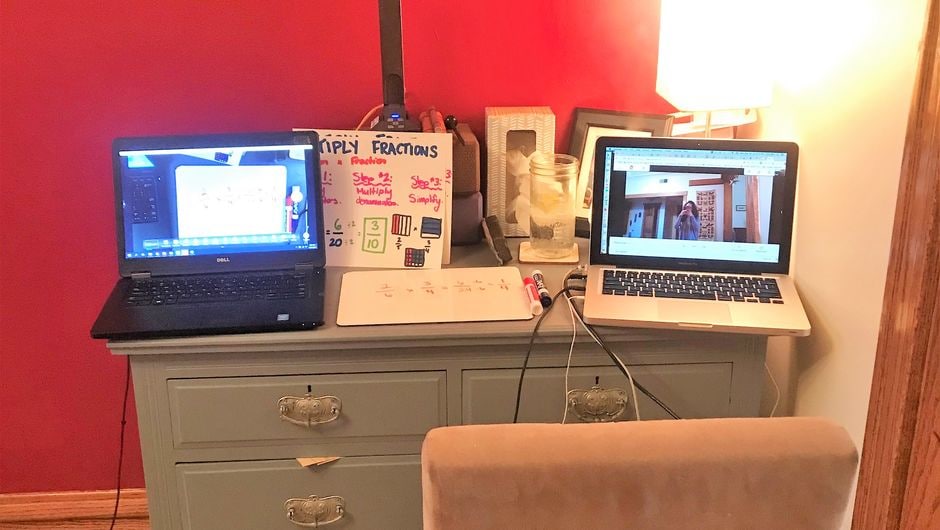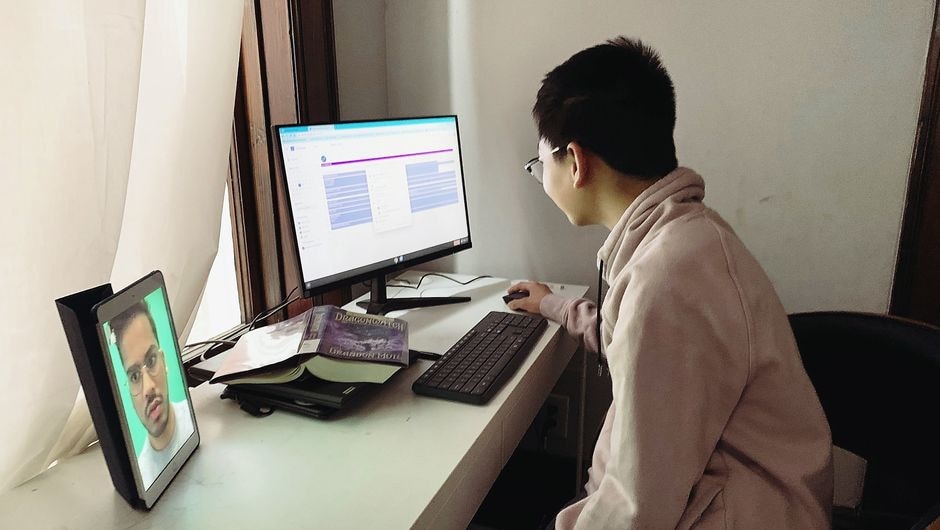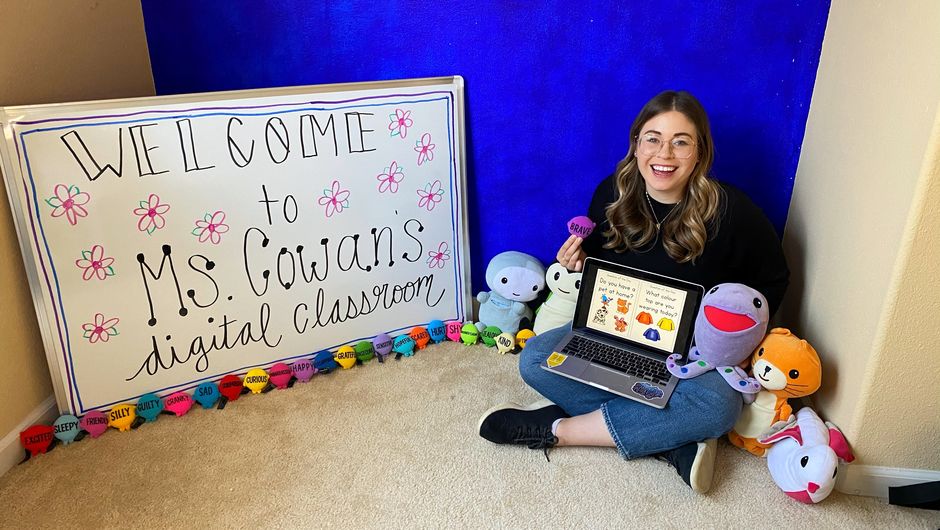
Getting Creative When Schools Go Remote
While schools remain closed due to COVID-19, teachers are finding innovative ways to adapt the traditional classroom to a new environment.
May 4, 2020
Teachers are nothing if not creative. On an ordinary day, teachers are masters of marshaling resources, planning on the fly, differentiating lessons for diverse learners, and so much more.
But the last six weeks have been far from ordinary. As thousands of teachers nationwide have transitioned to some form of remote teaching, the learning curve has been steep. For many teachers, the abrupt switch to online instruction has been a new and daunting experience.
At the same time, this transition has also been a testament to teachers’ resilience and willingness to go above and beyond. Whether it’s finding creative ways to provide one-on-one support, making space for important social interactions to happen online, or helping younger students make sense of Zoom, teachers are working hard to ensure students and their families have the support they need to keep going through this uncertain time.
Tackling the Technology Learning Curve (Even If You’re Not a Techie)
Almost overnight, thousands of teachers found themselves scrambling to figure out how to adapt learning to the remote classroom, ensure students had the technology and devices they needed, and choose from a dizzying array of distance learning platforms and tools. For most teachers, the sudden transition to remote teaching didn’t come with a handbook or much time to prepare. And yet, they are finding ways to replicate the classroom experience at home even without high-tech gear.
Julia Freedman (Chicago-Northwest Indiana ‘13) teaches a third grade bilingual class at Pulaski International School of Chicago. While she is grateful for the outpouring of resources and free online learning apps, like many teachers, she admits to feeling overwhelmed by all the new technology. What she really wants is guidance. “I don't need any more of the what's, I need the hows,” she says.
Though she describes herself as a “non-tech-savvy person,” Julia has come up with a clever way to bring her third-grade bilingual classroom into her living room. For her math lessons, she needs to be able to see her students while at the same time her students need to be able to see Julia’s whiteboard. But managing this on one computer was awkward.
So Julia figured out how to join her Google Meet sessions from both her school laptop and her personal laptop simultaneously. She uses her document camera with her school laptop, so students can see what she is writing, much like a whiteboard. She then uses her personal laptop to see a grid view of all of her students. All of these devices are carefully arranged on top of Julia's dresser—the only space she has for this setup. Students work out their math problems on paper with a marker so she can see their work when they hold it up to the camera. She also records these small group sessions, and the recording is automatically added to the calendar invite, so any students who missed class can easily find the recording.
“The lessons weren't my finest teaching,” Julia says. “But the fact that I was able to get through some objectives and my students were able to hold their work up to the camera so I could see what they were doing—they were like, ‘yeah, high five, we got this!’ That was a huge high for me this week.”

Every teacher's comfort level and experience with technology is different. But they are finding ways to make remote learning work with experimentation, ingenuity, and old-fashioned problem-solving skills.
Koral Valdez (Washington ‘15) teaches kindergarten at Valor Academy Elementary school in Los Angeles and also braced herself for the steep technology learning curve when her school transitioned to distance learning. Koral recalls spending weeks on her laptop from morning until night, trying to prepare everything her students and their parents needed to be successful with remote learning. She collaborated with the two other kindergarten teachers at her school and quickly learned how to create a class website—in both English and Spanish—that parents could use to keep track of their students' schedules and schoolwork, all in one place.
As a way to ease her students into remote learning, Koral also started posting videos of her lessons on her YouTube channel. With the help of her fiancé, she films herself acting out goofy introductions full of the joy and energy she’s used to bringing to the classroom. For her first video in the series, she shares her morning routine and “commute” to the living room where she now teaches.
“That was my way to start this new journey with my kids,” Koral says. “I think through those videos are just one way I’m trying to preserve some normalcy with my kids. That silliness and humanness and love—I feel like that's what my students need right now.”
Supporting Social-Emotional Learning
The rituals and routines that are held throughout the school day are a major part of any school’s culture, as well as a source of stability for students. While distance learning makes upholding rituals more challenging, many teachers have found creative ways to adapt these important parts of the school day to the online environment—starting with lunch.
When Kairos Academies in St. Louis switched to remote learning, preserving the important social interactions that happen over lunchtime was an important part of the transition. Students filled out a survey indicating who they would like to sit with at lunch. The school team worked to create small “virtual lunch” groups, pairing students up with their friend groups as much as possible. Every day during lunchtime, a staff member hosts a 30-minute remote lunch block where students gather and discuss a daily topic, and share how they are doing. One of the lunch groups now has a standing Fortnight appointment on Friday evenings.
Students also meet daily with their academic coach to go over their assignments and get help—a ritual that was already baked into their in-person day at Kairos but now happens over the phone or computer. This one-to-one connection allows students and teachers to remain in close contact now that they are no longer in the same building.

Nilesh Patel (Chicago-Northwest Indiana ‘15) is the science department chair at Kairos Academies and says maintaining these rituals is just as important as academics at this moment.
“Almost all of our kids are saying that they miss school and they want to come back just so we can all be part of our little community again,” Nilesh says. “So we're trying to keep that up as much as possible.”
Preserving other rituals, such as morning meetings, helps create a sense of normalcy and a way for students to connect with teachers at the start of the school day. These rituals also give students space to share how they are feeling and for teachers to do a pulse check on their students’ wellbeing.
Alexandra Cowen (Bay Area ‘18) teaches kindergarten at Bayview Elementary and still holds her morning meeting with her class. Even though it’s now on Zoom, it’s still an important space for Alexandra to check in with her students, and for her students to blow off some steam.
“I always open it up and give them an opportunity to all yell at the same time and then I mute them,” Alexandra says. “I do that a couple more times throughout the meeting, where they can all just go nuts because they're so excited to see everyone.”
Alexandra says her students miss school and the connection they have with her. In addition to small-group lessons, she has been intentional about building social-emotional learning into her remote classroom. This includes a weekly show-and-tell during which students give tours of their bedrooms and backyards, show off LEGO creations, and introduce classmates to their pets.

To help students process their big feelings around the quarantine, during her morning meeting Alexandra puts her Kimochis on camera—stuffed animals that come with colorful plush “feelings” and a curriculum to guide students through identifying and naming their emotions.
“Right now we're talking about being in a time where change is going to happen and we can't be in control of that,” Alexandra says. “So we're talking about being scared and brave during this time.”
Back in Chicago, Julia has also made social-emotional learning a big focus of her morning meeting with her third graders. She gives her students a discussion prompt and they take turns calling on each other on Zoom. Every day a different student gets dedicated air time to share something about themselves—often revealing a hidden talent such as playing the piano or guitar, which their classmates wouldn’t ordinarily get to see.
“I think students look to school as a place of community and as a place where they feel safe and in a world right now where safety is not guaranteed,” Julia says. “I think the more that we can offer them that sense, the more successful we'll be.”
Reinventing Collaboration Among Teaching Teams
While teachers are used to sharing resources working together in teams, this ends up looking very different when school teams are no longer together in the same building. Out of necessity, many teachers are reinventing the way they collaborate and manage their classrooms in order to make teaching remotely more effective and sustainable.
Julia and her fellow third-grade teachers realized early on that they could not run live instruction with an entire class of 25 eight- and nine-year-olds. Even with all the ground rules and community expectations in place, teaching a group that large was not manageable.
So Julia teamed up with the other third grade teachers at her school and found a creative solution to ensure all students were getting quality instruction time. They started by creating a Google site to organize school assignments and share resources with parents, which opened up more opportunities to collaborate on teaching. They discovered they could be much more effective by splitting up live instruction with small groups of students and taking turns recording mini-lessons using Loom. One teacher can work with a small group of students on math, while another works with a different small group on guided reading.
“All of a sudden I went from one brain to four brains,” Julia says. “We all seem to have a different specialty.”
Other teachers have come up with different approaches to remote collaboration that are making distance learning more manageable.
Jay Hu is in his first year of teaching seventh grade STEM in New York City, after completing the Breakthrough Collaborative teacher residency, one of Teach For America’s partner programs. At his school, teachers have developed a system for remote team teaching that he says is working really well. Rather than breaking students into small groups, students from the three STEM classes he teaches all meet at the same time. While having 83 students in one class may seem daunting, Jay says it works because he has three other staff members who support him during class. While he’s teaching, the facilitator checks students’ work and supports breakout rooms, the scholar manager tracks participation, keeps students on task and enters grades, and the tech support person handles any tech issues students may have.
“I think that’s been a good system,” Jay says. “It kind of lightens the load for teachers, and everyone can play a role."
“We are in a unique position to model humility, empathy, and perseverance. And I think that's what will matter to students in the long run.”
Finding New Ways to Meet Different Learning Needs
Online learning platforms come with their fair share of learning curves and technical issues. But many teachers have also found ways to use distance learning platforms and resources to differentiate instruction and provide targeted support.
During his STEM class, Jay uses breakout rooms in his web conferencing tool to work directly with students who may be struggling. While he provides focused small group support, the other three teachers who support his online classroom help monitor the rest of the class.
Remote learning can also give students an opportunity to focus on strengthening specific skills in an environment with fewer distractions.
Prior to school closures, students at Kairos already had a flexible schedule that included time for self-directed learning. Nilesh says that because students are used to working independently, they are now at a lower risk of falling behind after transitioning to remote learning. During independent work time, students who need extra help can focus on personalized learning from Khan Academy or IXL to target specific skill gaps. And students who are on track can choose from a list of extracurricular projects curated by teachers, such as virtual field trips to Mars or exploring NASA’s Curiosity rover.
Gavin Schiffres is the co-founder and CEO of Kairos Academies and says the school has been very deliberate about helping all students build the mindsets to succeed in a self-directed learning environment, which has made the transition to remote learning more equitable. Students are used to setting goals, backwards planning, and checking in with teachers and coaches.
“Overnight, every student in America suddenly is a professional remote teleworker,” Gavin says. “I'm not saying we've done a perfect job, but because we’ve spent a whole year intentionally thinking about executive functioning, our kids are better prepared and positioned to do that.”
What Matters Most: Being There for Students
Across the country, every teacher’s experience with remote teaching has been so different, especially with varying school contexts, and access to resources and support. While many teachers are feeling the stress of trying to deliver a quality education online in the midst of so much uncertainty, it’s a learning process that takes time, experimentation, and trial and error.
Students need support and connection from their teachers now more than ever. And as teachers continue to refine their approach to remote learning, Koral says the most important thing is to show up for kids and do your best.
“Teachers shouldn't feel pressured to do a bunch of things,” Koral says. “The one thing students will remember is you. As long as you be yourself with your students and you're trying, that's all that matters.”
When Julia looks back at the day her district announced that schools would be closed, she thinks about all the things she would have done differently to prepare her students, knowing what she knows now. At the same time, nothing could have prepared her for this. She encourages teachers to be forgiving of themselves, and focus on just being there for students.
“Students are never going to remember a worksheet that they do during a global pandemic, Julia says. “We are in a unique position to model humility, empathy, and perseverance. And I think that's what will matter to students in the long run."


